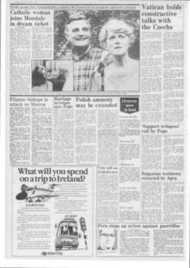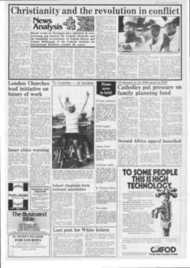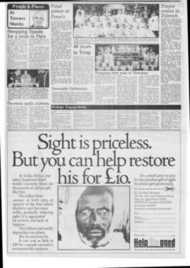Page 8, 20th July 1984
Page 8

Report an error
Noticed an error on this page?If you've noticed an error in this article please click here to report it.
Tags
Share
Related articles
Catholic Herald
Benedict Xvi's Mission To Restore
The Feast Of Pentecost
Alexander Lieven Examines A New Study Of Poland'...
The 1945 Opportunity For Britain
Heroes driven by belief in moral order
Li
FORTY years ago today, there occurred an event which profoundly shaped the course of European History. Unlike 6th June 1944, it will not be remembered by marches and speeches. Yet it was an event which pointedly displayed that Nazism had not destroyed the Christian soul of Germany, that the tyranny of Hitler had indeed united many Christians in a common cause long before Ecumenical Dialogue had been the accepted programme of the Catholic and Protestant Churches.
On 20th July 1944, a bomb exploded in the headquarters of Adolf Hitler at Rastenburg, Eastern Prussia. In the confusion which followed, believing that his bomb had killed Germany's leader, Count Claus Schenk von Stauffenberg returned to his aircraft to fly back to Berlin. There, at the War Office, he began to organise the overthrow of the Nazi State, the dismantling of the concentration camp system, and the return of a civilised government dedicated to peace and the restoration of a Christian Germany.
Yet the action was not that of one man, but of a group of German officers and politicians sickened by the brutality of the Nazi regime and concerned to end the war before Russian troops reached Berlin. They were deeply aware of the need to do something as Christians, despite the moral perplexities of the situation. Lutherans in particular were troubled by the traditinai allegiance of their religion to the State, but all agonised over the morality of assassination. Von Stauffenberg declared their moral anguish when he said, "We have tested ourselves before God. It must be done".
The officer who organised this attempt to redeem the soul of the German nation was unquestionably one of the most attractive personalities of the period. Dietrich Bonhoeffer symbolises alone the Christian opposition to Hitler, whereas the Catholic von Stauffenberg is little known. Both stand together as examples of the agonies of conscience which led churchmen and soldiers to engage in moral duplicity to overthrow a Government opposed to the Christian beliefs they held sacred.
Stauffenberg was only thirtyseven when he tried to kill Hitler. Remarkably handsome and outstandingly gifted as a soldier, he exerted a charismatic influence on those officers who joined him. In spite of his conservative Catholicism and his aristocratic background, by 1944 he had inclined toward fashioning a Socialist Germany out of the chaos of war.
His acceptance of Hitler, like that of many Germans, appears to have been occasioned by the belief that Nazism was preferable to Communism. However, he was one of those officers who urged a policy of fair treatment for the Russian populations captured in 1941, and many of the officers opposed to Hitler had similarly opposed the barbaric behaviour of the Nazis during the Russian Campaign.
In 1943, in North Africa, he was severely wounded by an Allied aircraft, losing an eye and his right hand. From then onwards, as a result of this personal experience of the suffering of war, he was determined to destroy Hitler. He had links with the Kreisaw Circle of intellectuals, including the Jesuit Fr Delp, who drew up a plan for a new social order in Germany.
As the Gestapo began to get closer to the centre of the conspiracy, Stauffenberg decided to act, although the chances of success were limited. As Chief of Staff, he was responsible for the implementation of Operation Valkyrie, the plan for the , restoration of authority if there were a breakdown of order in Germany. He decided to ensure that breakdown by killing Hitler and implementing Valkyrie in favour of the conspirators.
Soon after arriving in Berlin on 20th July, Stauffenberg. activated Valkyrie. There had been serious delays before his return, and the effect of the order was soon nullified by the unmistakable tone of Hitler's voice on the radio. A pro-Nazi unit under Major Otto Ernst Remer surrounded the War Office. Otto Skorzeny, who had rescued Mussolini from captivity on an Italian mountain, restored order in other areas.
By the evening of 20th July, Stauffenberg and three of his aides had been executed in the yard of his headquarters. The blood purge of the others would soon follow, a purge which deprived Germany of many of those whom Stauffenberg had hoped would recreate a moral and politically respectable nation.
He had shown that there were German Christians prepared to die for their belief that there was a moral order higher than that of the Nazi State. His action is an outstanding example of the use of Christian conscience in a situation of moral complexity. With many of his coconspirators, he felt that to do. nothing was wrong; there was a need for some act of resistance by the ruling classes of Germany to expiate the sins of the tyranny they had helped gain power. Even if that act failed, there seemed to be a moral obligation involved in at least attempting it.
As Bishop Bell of Chichester declared in 1957: "It is no wonder, surely, that members of the Christian Church in Germany, both Protestants and Catholics, should be prominent in it. Nor should it be surprising that churchmen utside Germany who knew something of the conflict within that country, should give it public support, even in time of war." Our memories are short. The conspirators of July 1944, deserve more than a footnote in history books, especially from the Christian Church who gave to them the values which inspired them to resist evil to the point of death.
Fr Patrick Tansey
blog comments powered by Disqus










